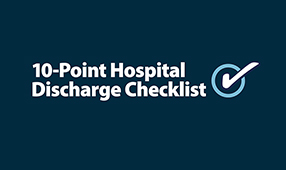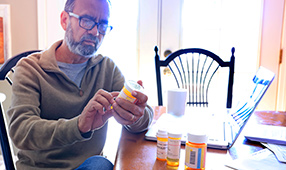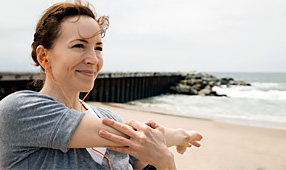Key takeaways
- Today’s smart technology makes it easy for educators to focus on their health without a significant financial or time commitment.
- Some devices allow for diagnostic testing without ever entering a doctor’s office.
Educators are notorious for putting their own health on the back burner, focusing their energies on caring for others instead. Fortunately, today’s smart technology makes it easier than ever for educators to shift that mindset without a significant financial or time commitment. “Educators are especially in need of self-care tools that don’t require them to be at a desk or in a doctor’s office,” explains Jan Oldenburg, Founder of Jan Oldenburg Consulting, which offers patient engagement solutions to leaders in the health care industry.
Instead of spending hours “Googling” symptoms, busy educators can videoconference with their doctors right from their home computer or smart phone. There are even devices that allow for diagnostic testing without ever entering a doctor’s office—such as blood pressure readings and electrocardiogram recordings.
While they do provide convenience and guidance, do smart technologies deliver on their promises of better health? Here’s what you need to know about 5 up-and-coming high-tech tools:
1. Health apps: The health and fitness app market has exploded over the last few years with options that promise to help you lose weight, build strength and flexibility, even map out your run and stay on top of your nutrition. More advanced apps allow you to track your sleep patterns, respiration and offer tools like simple meditation tracks to enhance your health and wellbeing. A bonus: Many of these apps cost less than a gussied up cup of joe!
Examples: MyFitnessPal, MapMyRun, Headspace, Calm and countless others!
Caveats: Unfortunately, apps are completely unregulated. “You may have to read a lot of reviews and kiss a few frogs before you find an app that aligns with your goals,” says Oldenburg. Then ask your doctor to “approve” any apps you intend to use.
2. Electronic medical portals: With the ability to make and change appointments, communicate electronically with your doctor, refill prescriptions and review lab results, online Web portals are becoming increasingly popular. Just log into your provider’s medical portal using your secured user name and password and you’ll access a treasure trove of data and opportunities.
Examples: Patient Fusion, MyChart
Caveats: Docs are leery of releasing test results for fear of causing unnecessary confusion and anxiety, so most portals are hard to navigate and incomplete. “You can’t download your data, scans or lab results, so you still don’t ‘own’ your own data,” says Eric Topol, M.D., cardiologist and professor of genomics at Scripps Research Institute.
3. At-home disease monitoring: Whether you have diabetes, hypertension, asthma or some other chronic condition, at-home monitoring typically works one of two ways: 1. Wearable devices connect to your smartphone or work on their own to monitor your breathing, blood pressure, heart rate or blood-sugar levels from the comfort of your own home (or wherever you happen to be standing!). 2. Automated text messaging programs send alerts to your phone to remind you to take your medication or check your blood sugar.
Examples: Withings Wireless Blood Pressure Monitor; AliveCor Heart Monitor; PropellerHealth.
Caveats: Some of these devices are expensive and they’re usually not covered by insurance. “Moreover, only a small number have been validated (in terms of FDA approval, and in peer-reviewed medical journals) to prove they work,” says Topol. “So, it’s buyer beware.”
4. Wearable fitness devices: Wearable fitness devices from pedometers to wristwatches track your steps, count your calories and monitor sleep patterns. The best devices not only offer workouts and tracking technology, but also devise a way for you to align yourself with others who share your goals, triumphs and struggles. A bonus: Knowing you have to come clean about indulgent bouts of mindless eating may make you think twice before hitting the fridge.
Examples: Fitbit, Moov Now, Garmin, Apple Watch
Caveats: Don't count on these gadgets to change your habits long term. Research shows after six months, a third of users have stowed these in a drawer. They also may not be accurate in measuring calorie needs. “But even if these devices aren’t completely accurate in terms of counting steps or assessing respiration, they’re making you aware of your patterns,” says Oldenburg—and that can be priceless.
5. Telemedicine and virtual office visits: The benefits of telemedicine are huge. If you have a mysterious mole that crops up overnight, or an itch that just won’t quit, chatting with a doc on-demand can be life altering. “Instead of waiting 2.6 weeks, the average time it takes to get an appointment with a primary care doctor, you can chat ‘live’ with a doctor within 2.6 seconds,” says Topol. There’s no commute and no risk of getting sick from ill patients sitting next to you in the waiting room. It’s cheaper, too. With fees ranging from $40 to $150, you can arrange an e-visit, Skype or GoogleHangout with a doctor, nurse or holistic practitioner. And many platforms are available 24/7, says Topol.
Examples: Doctor on Demand, MDLIVE, LiveHealth Online
Caveats: Virtual doctor services can be difficult to find, and docs may feel increased pressure to prescribe meds when the patient only needs fluids and rest. Plus, says Family Physician Mia Finkelston, M.D. in Leonardtown, MD, telemedicine is not meant to replace your primary care physician, but rather to augment the care patients receive.
No matter what your body needs, having these tools at your fingertips could help pave the way to successful healing and health maintenance. Whether your goal is to track your steps, map your run or keep your blood sugar in check, there’s no shortage of options in today’s digital marketplace. And since students learn by watching their teachers, you’re in a unique place to help guide the next generation and how they manage their health.
“Educators pass on attitudes to children and the community,” says Oldenburg. “When they start taking ownership of their health, asking questions and challenging the system, everyone wins.”












